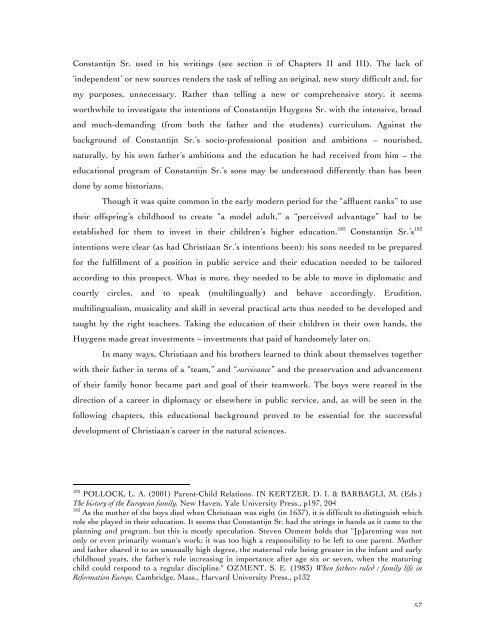Christiaan Huygens – A family affair - Proeven van Vroeger
Christiaan Huygens – A family affair - Proeven van Vroeger
Christiaan Huygens – A family affair - Proeven van Vroeger
Create successful ePaper yourself
Turn your PDF publications into a flip-book with our unique Google optimized e-Paper software.
Constantijn Sr. used in his writings (see section ii of Chapters II and III). The lack of<br />
‘independent’ or new sources renders the task of telling an original, new story difficult and, for<br />
my purposes, unnecessary. Rather than telling a new or comprehensive story, it seems<br />
worthwhile to investigate the intentions of Constantijn <strong>Huygens</strong> Sr. with the intensive, broad<br />
and much-demanding (from both the father and the students) curriculum. Against the<br />
background of Constantijn Sr.’s socio-professional position and ambitions <strong>–</strong> nourished,<br />
naturally, by his own father’s ambitions and the education he had received from him <strong>–</strong> the<br />
educational program of Constantijn Sr.’s sons may be understood differently than has been<br />
done by some historians.<br />
Though it was quite common in the early modern period for the “affluent ranks” to use<br />
their offspring’s childhood to create “a model adult,” a “perceived ad<strong>van</strong>tage” had to be<br />
established for them to invest in their children’s higher education. 182 Constantijn Sr.’s 183<br />
intentions were clear (as had <strong>Christiaan</strong> Sr.’s intentions been): his sons needed to be prepared<br />
for the fulfillment of a position in public service and their education needed to be tailored<br />
according to this prospect. What is more, they needed to be able to move in diplomatic and<br />
courtly circles, and to speak (multilingually) and behave accordingly. Erudition,<br />
multilingualism, musicality and skill in several practical arts thus needed to be developed and<br />
taught by the right teachers. Taking the education of their children in their own hands, the<br />
<strong>Huygens</strong> made great investments <strong>–</strong> investments that paid of handsomely later on.<br />
In many ways, <strong>Christiaan</strong> and his brothers learned to think about themselves together<br />
with their father in terms of a “team,” and “survi<strong>van</strong>ce” and the preservation and ad<strong>van</strong>cement<br />
of their <strong>family</strong> honor became part and goal of their teamwork. The boys were reared in the<br />
direction of a career in diplomacy or elsewhere in public service, and, as will be seen in the<br />
following chapters, this educational background proved to be essential for the successful<br />
development of <strong>Christiaan</strong>’s career in the natural sciences.<br />
182 POLLOCK, L. A. (2001) Parent-Child Relations. IN KERTZER, D. I. & BARBAGLI, M. (Eds.)<br />
The history of the European <strong>family</strong>. New Haven, Yale University Press., p197, 204<br />
183 As the mother of the boys died when <strong>Christiaan</strong> was eight (in 1637), it is difficult to distinguish which<br />
role she played in their education. It seems that Constantijn Sr. had the strings in hands as it came to the<br />
planning and program, but this is mostly speculation. Steven Ozment holds that “[p]arenting was not<br />
only or even primarily woman's work; it was too high a responsibility to be left to one parent. Mother<br />
and father shared it to an unusually high degree, the maternal role being greater in the infant and early<br />
childhood years, the father's role increasing in importance after age six or seven, when the maturing<br />
child could respond to a regular discipline." OZMENT, S. E. (1983) When fathers ruled : <strong>family</strong> life in<br />
Reformation Europe, Cambridge, Mass., Harvard University Press., p132<br />
57


